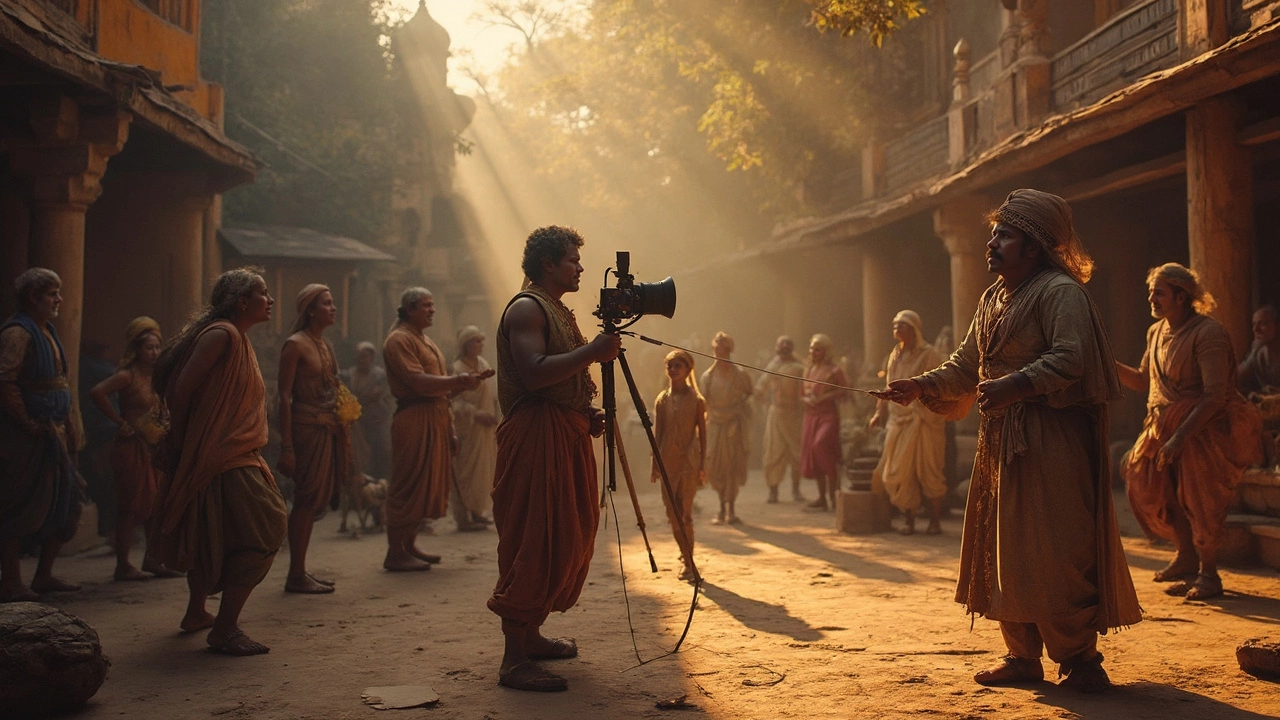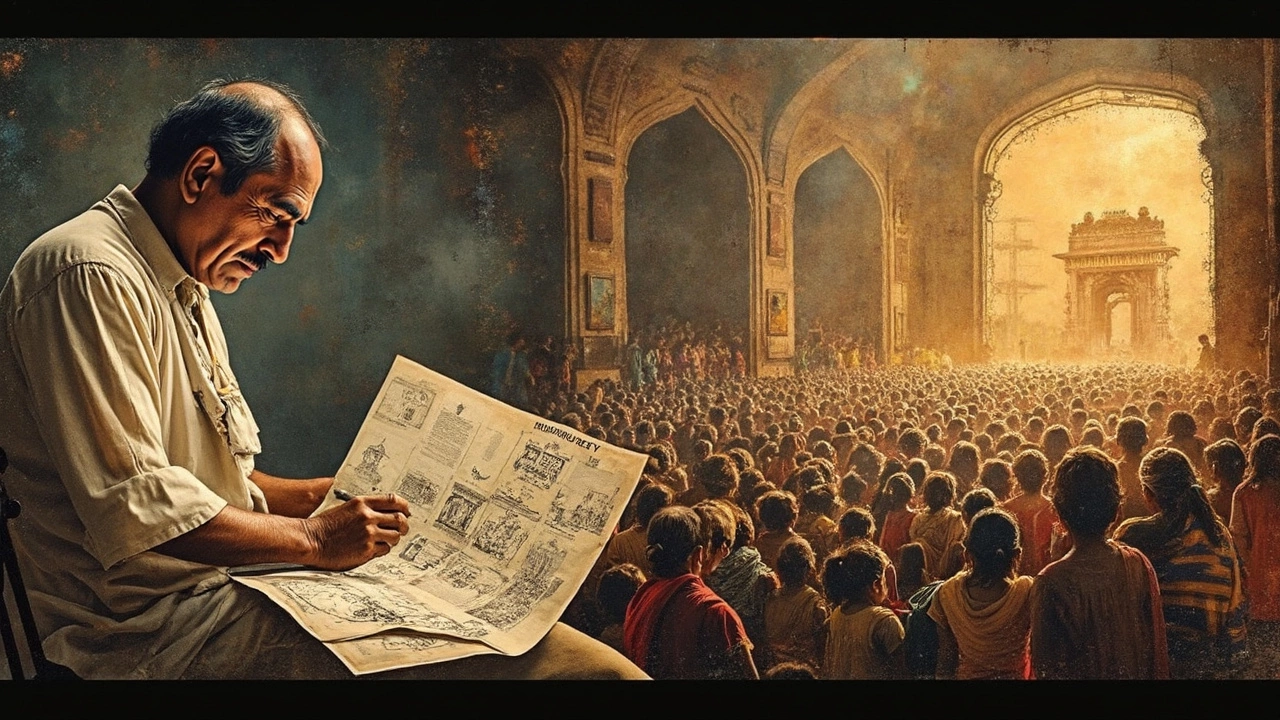Who Is the First India Director? The Real Story Behind Indian Cinema’s First Director
 May, 14 2025
May, 14 2025
Think Bollywood’s been around forever? Not really. Indian cinema started thanks to one gutsy guy who decided India needed its own movies—back when the country barely had electricity. That guy was Dadasaheb Phalke, and you can’t talk about Indian directors without mentioning his name.
Phalke didn’t just make movies—he invented a whole industry from scratch. There was no how-to guide. No ready camera crew. Just his obsession, a homemade camera, and a whole lot of trial and error. If you’ve ever wondered how Indian movies got their start or why Phalke’s name always pops up in movie trivia, you’re about to find out.
- Setting the Scene: What Was Cinema Like in Early India?
- Meet Dadasaheb Phalke: The Father of Indian Cinema
- Raja Harishchandra: India’s First Feature Film
- Challenges and Innovations: How Phalke Changed the Game
- Why This Legacy Still Matters
Setting the Scene: What Was Cinema Like in Early India?
Going back to the early 1900s, movies weren't really a thing in India. Instead, folks saw live plays, watched street magicians, or listened to storytellers at local fairs. If you even heard of a moving picture, it was probably foreign—brought over by British operators or European companies. People dressed up for "bioscope" shows, which were basically silent short films with no Indian faces or themes.
The country’s very first public screening was way back in 1896, when the Lumière Brothers’ crew rolled into Bombay (now Mumbai). These films ran under ten minutes and showed everyday scenes from Europe, like a train arriving or people having lunch. Still, they wowed the crowds because something moving on a screen was brand-new.
| Year | Event | Place |
|---|---|---|
| 1896 | First public film screening in India (Lumière Brothers) | Watson Hotel, Bombay |
| 1901 | First Indian short film footage (a wrestling match) | Calcutta |
| 1913 | First *Indian* feature film made by an Indian director | Bombay |
But local stories and culture were missing until someone homegrown stepped up. Around this time, foreign newsreels and imported short films were popular, but nobody thought about making a full movie in India for Indians. Technically, a few tried shooting snippets—a wrestling match here, a street scene there—but there were no real stories yet.
Gear was hard to get, film reels cost a fortune, and most folks in India weren’t sure movies would ever take off. Imagine trying to make a film without YouTube tutorials or a film school anywhere in sight. That’s why first Indian director stories matter: they’re about people doing what seemed impossible back then.
So, the scene was all set for someone to take a leap—and change things for good.
Meet Dadasaheb Phalke: The Father of Indian Cinema
When folks ask who started it all for Indian movies, only one name always comes up—Dadasaheb Phalke. Born Dhundiraj Govind Phalke in 1870, he had a background in photography and printing before movies even showed up in India. His friends thought he was a bit odd for being obsessed with the moving pictures he saw from Europe, but he didn’t care. He saw something big in it for India—and he went all in.
Phalke watched a silent film called The Life of Christ in 1910, and it fired him up enough to teach himself filmmaking. Back then, there were zero film schools, no local studios, and hardly anyone in the country who even knew what a film director did. Phalke sold off family stuff and even pawned his wife’s jewelry to fund his dream of making a movie. No backers, no sponsors—just insane commitment.
Here’s why Phalke mattered so much:
- He directed India’s very first full-length feature film, Raja Harishchandra, released in 1913.
- He learned all the tricks himself—writing scripts, handling cameras, developing film reels, even handling set design.
- Phalke trained his whole crew from scratch because nobody around knew filmmaking basics.
- He specifically decided to feature Indian stories, myths, and legends so Indian audiences could connect to the screen.
Take a look at some quick stats about Phalke and his legendary work:
| Year | Key Event |
|---|---|
| 1870 | Phalke born in Maharashtra |
| 1910 | Saw The Life of Christ |
| 1912 | Started working on Raja Harishchandra |
| 1913 | Raja Harishchandra was released |
| 1917–1937 | Produced over 95 movies and documentaries |
Phalke didn’t slow down after his first hit. He pushed out documentaries and short films, slowly building the first real film community in India. So, if you love Indian movies or you’re just curious about where Indian cinema history began, this is the guy you need to know.

Raja Harishchandra: India’s First Feature Film
So, here’s where first Indian director Dadasaheb Phalke really made his mark. Back in 1913, he released Raja Harishchandra, the first full-length Indian movie. This wasn’t just a short clip—Phalke managed a 40-minute silent film at a time when almost no one in India even knew how to make movies. He wrote it, directed it, produced it, and even handled some of the trick shots and editing.
The plot follows Harishchandra, a king from Hindu mythology, who sticks to his word no matter how tough things get. The story itself was popular, but what really blew people’s minds was seeing Indian actors and Indian costumes on screen for the first time. There were no female actors around who’d agree to appear in public, so men played all the roles—even the queens and servants.
Phalke’s wife got involved too, mostly behind the scenes—she cooked meals for the cast and helped with costumes. They shot the movie in Phalke’s own house and backyard, because there were no real movie studios in India yet. When Raja Harishchandra finally premiered at the Coronation Cinema in Bombay on May 3, 1913, people were glued to their seats. Tickets for the first few shows sold out almost instantly.
Curious about how groundbreaking it was? Here’s a glimpse of what made it special:
- It cost around 15,000 rupees to make—a giant sum back then.
- Phalke trained everyone on set, since no one really knew how to act for film.
- The movie was silent, with intertitles in both English and Marathi so everyone could follow.
| Fact | Detail |
|---|---|
| Release Date | May 3, 1913 |
| Director | Dadasaheb Phalke |
| Running Time | Around 40 minutes |
| Language | Silent film (English and Marathi intertitles) |
| Lead Actor | Dattatraya Damodar Dabke (played Harishchandra) |
If you’re into movie history, Raja Harishchandra is basically the blueprint. Everything that makes Indian cinema unique—mythological stories, bold experiments, and even people putting family into the work—starts here. No digital effects, no formal training, just pure determination and guts.
Challenges and Innovations: How Phalke Changed the Game
Ever tried making a movie before Google, YouTube, or even real film schools? That’s exactly what Dadasaheb Phalke did in 1912. Most folks doubted him, thinking movies were just a silly Western fad. The equipment? Imported and super expensive. Film reels would get stuck or burn up because of the heat. He had to figure out everything himself—developing film in his bathroom, hand-painting movie posters, and training actors who’d never even seen a camera before.
Back then, acting in films was so strange that Phalke couldn’t even convince women to act—he had to cast a male cook named Anna Salunke in a female role for Raja Harishchandra. Most people thought acting on screen was beneath them. To get enough money, Phalke pawned his wife’s jewelry and took loans. No one in India had shot a feature-length film before, so every turn meant a brand-new problem no one had ever faced.
One big trick Phalke borrowed from the West? Special effects. He used simple camera cuts and double exposures to make things disappear or transform, blowing people’s minds back then. Once, he used time-lapse photography to show a plant growing—something nobody had pulled off in Indian movies at the time.
- Imported his first camera from London after selling family gold
- Trained his own crew because no experts existed in India
- Built homemade sets and props
- Processed black-and-white film in his kitchen and bathroom
Here’s a quick peek at how tough it actually was for Phalke to make Raja Harishchandra work:
| Year | Challenge | Phalke’s Hack |
|---|---|---|
| 1912-1913 | No trained actors, costly film | Casted male actors for female roles, trained family/friends |
| 1913 | Film developing issues | Used home setups, improvised chemicals |
| 1913 | No audience for Indian films | Marketed the movie with live demos and bold posters |
Phalke wasn’t just the first. He built the whole playbook. His scrappy style—doing whatever it took—kicked off the film industry in India. That’s why anyone who studies first Indian director stories, or just loves movie trivia, should know his name off the top of their head.

Why This Legacy Still Matters
If you’ve ever wondered why award ceremonies in India are named after Dadasaheb Phalke, it’s because his impact won’t go away. Phalke didn’t just make a movie; he showed millions that storytelling with a camera was possible on Indian soil, way back in 1913. That’s what’s wild: he made first Indian director a title instead of just a dream.
People still praise his DIY spirit. He built his own film equipment, trained family and neighbors as actors, and basically hustled until he made it work. This "make it happen even if you’ve got nothing" attitude still fires up a ton of new Indian filmmakers—many of whom start with low budgets just like Phalke.
Want proof his work set the standard? Look at the yearly Dadasaheb Phalke Award, the biggest honor for Indian cinema legends since 1969. Directors like Satyajit Ray and Yash Chopra have been recognized with it. No matter what language—Hindi, Tamil, Bengali—everyone knows that chasing this award means chasing true movie greatness.
| Fact | Detail |
|---|---|
| First film made | Raja Harishchandra (1913) |
| Indians working in film industry today | Over 2 million |
| Dadasaheb Phalke Award started | 1969 |
New filmmakers still look at Phalke’s story for ideas when they feel stuck. If your phone can shoot video, you’re halfway to following in his steps. He proved you don’t need perfect conditions—just stubbornness and a pretty wild idea.
At the end of the day, Phalke’s legacy isn’t just about nostalgia. It’s a reminder to today’s movie lovers and creators that one person’s garage project can change screens for generations. So, if you’re thinking about making something, don’t wait for the stars to align. Phalke didn’t—and India’s film scene is still richer because of it.